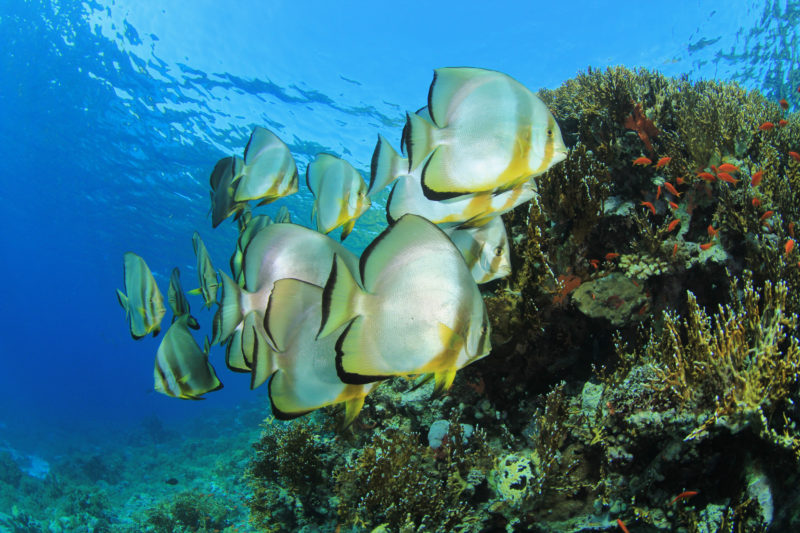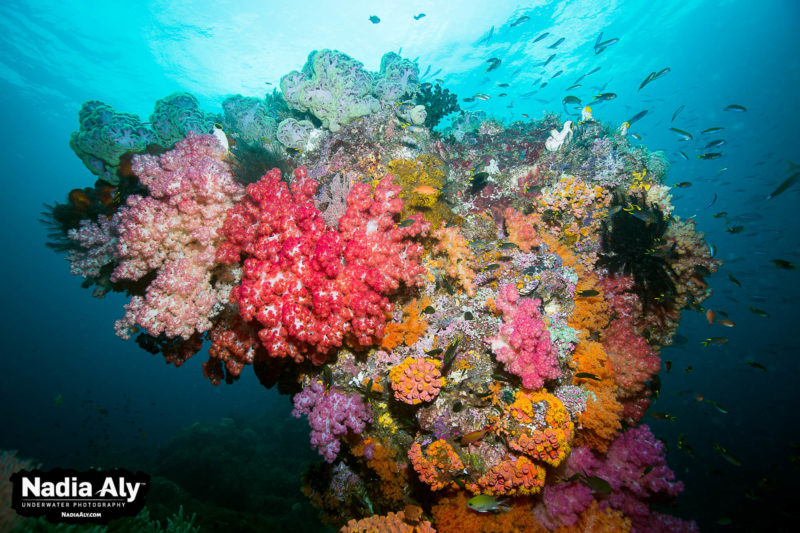Less than 5 percent of the world’s oceans are protected within marine reserves, and many in the United States are facing possible reduction. Marine reserves help protect fisheries, coral reefs, and ocean biodiversity from the impact of human activities and climate change. They provide opportunities for sustainable dive tourism and important income for local communities. Marine-park fees are often used to educate communities and tourists about issues such as sustainable fishing and conservation. Marine reserves also provide unique study environments, such as the research station on Palmyra Atoll in the Pacific Remote Islands group. Now is a great time make eco-conscious travel choices and support world-class marine reserves around the globe. Here are our picks for 10 of the top dive destinations supporting marine reserves.
Ras Mohammed, Egypt
Ras Mohammed offers some of the Red Sea’s best diving. The water is warm year-round; there are a variety of dive sites for new and experienced divers; and sites are accessible via liveaboard or day-boat safaris. The marine reserve has been in place since the 1980s and covers 133 square miles (345 square km). It lies just 12 miles (20 km) away from the popular tourist destination of Sharm el Sheikh. Ras Mohammed is known for its colorful hard and soft corals and abundant fish life.
Cocos Island, Costa Rica
Cocos Island, designated a World Heritage Site by UNESCO in 1997, lies over 300 miles (500 km) from the Costa Rican Pacific coast. This remote island is most famous for sharks, particularly schooling hammerheads, which are present year-round. With over 20 dive sites to explore and crystal-clear waters, Cocos offers some of the best diving in Central America and the world, but conditions can be challenging. Only advanced divers should visit Cocos.
Hol Chan, Belize
Hol Chan, or “little blue channel,” became a marine reserve in 1987. It is home to numerous fish species, such as snappers, groupers and colorful parrotfish. Hol Chan is famous for night dives along the Mesoamerican Reef and water temperatures range from 79 to 86 F (26 to 30 C), making it a great year-round destination.
Galapagos Marine Reserve, Galapagos
A visit to the Galapagos is on nearly every diver’s bucket list. These volcanic islands feature diverse life, both above and below water, with some found nowhere else on Earth. Visitors can see marine iguanas, penguins, sea lions, numerous shark species and mantas, to name only a few. The Galapagos is suitable for new and experienced divers and a range of Galapagos liveaboard safaris and resort-based dive centers are available.
Jardines de la Reina, Cuba
The reef at Jardines De La Reina is pristine, extends over 840 square miles (2,000 square km) and features 80 dive sites. All are sheltered from currents and wind, making this marine reserve perfect for new divers. The dive sites include wall dives with sponges and corals, drop-offs and opportunities to dive with great hammerheads, nurse sharks and more.
Raja Ampat, Indonesia
Raja Ampat is an archipelago of over 1,500 small islands and cays surrounding four main islands. It’s part of the Coral Triangle, containing the highest global marine diversity on the planet. This marine reserve is home to over 1,000 species of fish and more than 500 species of coral. Mantas are frequent visitors to the area, as are turtles and dolphins. There are a variety of Raja Ampat liveaboards available to explore the many dive sites.
Wakatobi, Indonesia
Wakatobi encompasses a group of four remote islands in Sulawesi, and the marine reserve covers 5,367 square miles (13,900 square km). With consistently warm waters, and a notably short wet season, diving is spectacular year-round. Divers can also see short-finned pilot whales from November to April and enjoy the hundreds of fish species found in the reserve.
Mu Koh Lanta National Park, Thailand
Thailand established Mu Koh Lanta National Park in 1990. It lies 43 miles (70 km) from the province of Krabi. This national park has some of west Thailand’s best diving, including cave and wreck dives, underwater pinnacles covered in marine life, and the chance to see whale sharks. With world-class beaches and a laid-back atmosphere, Koh Lanta’s coast is a popular destination for all.
Bunaken National Marine Park, Indonesia
Bunaken has a staggering diversity of fish life. Divers can see up to 70 percent of all fish species found in the Indo-Western Pacific in this marine park, stretching across 344 square miles (890 square km). The park is home to sea turtles, dugong, occasional sperm whales, and an abundance of small critters for keen underwater photographers.
Namena, Fiji
This marine reserve, lying between two Fijian islands, has existed since 1997. It’s great for both snorkelers and divers. The reserve contains over 1,200 species of fish and is home to numerous large species such as reef sharks, hammerheads, manta ray and pelagic fish. Hawksbill turtles nest on the islands and lucky divers may witness humpback whales coming to the area to calve.
Kathryn Curzon, a diver and writer for Liveaboard.com, contributed this article.







